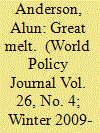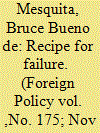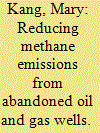|
|
|
Sort Order |
|
|
|
Items / Page
|
|
|
|
|
|
|
| Srl | Item |
| 1 |
ID:
092839


|
|
|
|
|
| Publication |
2009.
|
| Summary/Abstract |
This paper investigates the potential for making deep cuts in US transportation greenhouse gas (GHG) emissions in the long-term (50-80% below 1990 levels by 2050). Scenarios are used to envision how such a significant decarbonization might be achieved through the application of advanced vehicle technologies and fuels, and various options for behavioral change. A Kaya framework that decomposes GHG emissions into the product of four major drivers is used to analyze emissions and mitigation options. In contrast to most previous studies, a relatively simple, easily adaptable modeling methodology is used which can incorporate insights from other modeling studies and organize them in a way that is easy for policymakers to understand. Also, a wider range of transportation subsectors is considered here-light- and heavy-duty vehicles, aviation, rail, marine, agriculture, off-road, and construction. This analysis investigates scenarios with multiple options (increased efficiency, lower-carbon fuels, and travel demand management) across the various subsectors and confirms the notion that there are no "silver bullet" strategies for making deep cuts in transport GHGs. If substantial emission reductions are to be made, considerable action is needed on all fronts, and no subsectors can be ignored. Light-duty vehicles offer the greatest potential for emission reductions; however, while deep reductions in other subsectors are also possible, there are more limitations in the types of fuels and propulsion systems that can be used. In all cases travel demand management strategies are critical; deep emission cuts will not likely be possible without slowing growth in travel demand across all modes. Even though these scenarios represent only a small subset of the potential futures in which deep reductions might be achieved, they provide a sense of the magnitude of changes required in our transportation system and the need for early and aggressive action if long-term targets are to be met.
|
|
|
|
|
|
|
|
|
|
|
|
|
|
|
|
| 2 |
ID:
092727


|
|
|
|
|
| Publication |
2009.
|
| Summary/Abstract |
Modern portfolio theory is applied to the problem of selecting which vehicle technologies and fuels to use in the next generation of vehicles. Selecting vehicles with the lowest lifetime cost is complicated by the fact that future prices are uncertain, just as selecting securities for an investment portfolio is complicated by the fact that future returns are uncertain. A quadratic program is developed based on modern portfolio theory, with the objective of minimizing the expected lifetime cost of the "vehicle portfolio". Constraints limit greenhouse gas emissions, as well as the variance of the cost. A case study is performed for light-duty passenger vehicles in the United States, drawing emissions and usage data from the US Environmental Protection Agency's MOVES and Department of Energy's GREET models, among other sources. Four vehicle technologies are considered: conventional gasoline, conventional diesel, grid-independent (non-plug-in) gasoline-electric hybrid, and flex fuel using E85. Results indicate that much of the uncertainty surrounding cost stems from fuel price fluctuations, and that fuel efficient vehicles can lower cost variance. Hybrids exhibit the lowest cost variances of the technologies considered, making them an arguably financially conservative choice.
|
|
|
|
|
|
|
|
|
|
|
|
|
|
|
|
| 3 |
ID:
094260


|
|
|
| 4 |
ID:
085442


|
|
|
|
|
| Publication |
2008.
|
| Summary/Abstract |
The assignment of obligations to pay for mitigation of greenhouse gas emissions and for adaptation to unavoidable climate change is a critical and controversial component of international negotiations under the United Nations Framework Convention on Climate Change. In this article we present a new framework called 'Greenhouse Development Rights' (GDRs): a formula for the calculation of national obligations on the basis of quantified capacity (wealth) and responsibility (contribution to climate change). GDRs seek to preserve the 'right to development' by exempting from obligation any income and emissions under a 'development threshold'. By taking into account the distribution of income and emissions within countries, and calculating national obligations as if they were the aggregated obligations of individuals, the framework treats every global citizen identically, and allocates obligations even to poor countries that are proportional to their actual middle-class and wealthy populations. When coupled to a trajectory of rapid emissions reductions (for example, 80 per cent reduction below 1990 levels by 2050), the framework results in larger reduction obligations for both rich and poor countries than they currently seem prepared to accept. However, the formula may be 'fair enough' to break the impasse that currently separates rich and poor countries in the negotiations.
|
|
|
|
|
|
|
|
|
|
|
|
|
|
|
|
| 5 |
ID:
094360


|
|
|
| 6 |
ID:
091469


|
|
|
|
|
| Publication |
2009.
|
| Summary/Abstract |
Want to know what's going to happen with climate change? Is the world going to come together this Dcember at the Copenhagen summit or at some future date, and regulate away enough of the Greenhouse gases that are heating up the planet to warm Al Gore's heart?
|
|
|
|
|
|
|
|
|
|
|
|
|
|
|
|
| 7 |
ID:
166999


|
|
|
|
|
| Summary/Abstract |
Well plugging, the main strategy for reducing methane emissions from millions of unplugged abandoned oil and gas (AOG) wells in the U.S. and abroad, is expensive and many wells remain unplugged. In addition, plugging does not necessarily reduce methane emissions and some categories of plugged wells are high emitters. We analyze strategies and costs of five options for reducing methane emissions from high-emitting AOG wells - those which are unplugged and plugged/vented gas wells. The five options are: plugging without gas venting, plugging with gas venting and flaring, plugging with gas venting and usage, gas flaring only, and gas capture/usage only. Average plugging costs ($37,000 per well) can be justified by the social cost of methane, which considers air quality, climate, and human/ecosystem impacts. Savings as measured by natural gas prices and alternative energy credits can offset low plugging costs (<$15,400 per well) but are not large enough to offset average plugging costs. Nonetheless, reducing methane emissions from AOG wells is a cost-effective strategy for addressing climate change that has comparable costs to some current greenhouse gas mitigation options and can produce co-benefits such as groundwater protection. Therefore, we recommend including the mitigation of AOG wells in climate and energy policies in the U.S., Canada, and other oil-and-gas-producing regions.
|
|
|
|
|
|
|
|
|
|
|
|
|
|
|
|
| 8 |
ID:
080912


|
|
|
|
|
| Publication |
2008.
|
| Summary/Abstract |
The possibility of nuclear power in Southeast Asia to help meet huge growth in electricity demand has suddenly risen in government planning. Vietnam, Indonesia and Thailand have plans for nuclear power generation while Malaysia and the Philippines are studying the option. These plans and possibilities raise a gamut of economic, environmental and security issues and fears which policy makers are only beginning to grapple with. As in other parts of the world, both where there are established nuclear generation industries and where there are not, nuclear power is being turned to as a possible solution to meeting demand when the cost of traditional fossil fuels used for generation, coal and natural gas, are rising steeply, and in a way that mitigates against contribution by fossil fuel combustion to the greenhouse effect and predicted global warming. But how governments in Southeast Asia go about implementing nuclear power is still far from clear. Optimal development from economic, environmental and security points of view would argue for a cooperative approach via the Association of Southeast Asian Nations (ASEAN), possibly through an ASEAN nuclear power authority. So far, plans for nuclear power generation are fairly limited when considered against total projected power demand. But they may be the precursor to a much greater commitment to nuclear power if first plants are successfully developed. Managing the development of nuclear power will be a major test of ASEAN's maturity and effectiveness
|
|
|
|
|
|
|
|
|
|
|
|
|
|
|
|
|
|
|
|
|